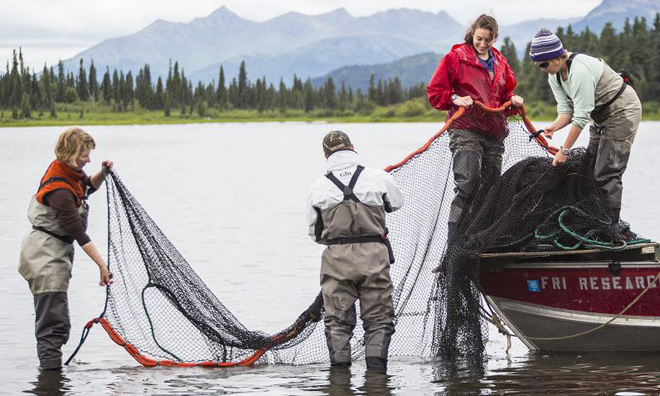
“Male, brain, body.” “Female, belly.”
Seven days a week, Sarah Schooler, ’15, suits up in chest-high waders, grabs her bear spray, hops a boat, and walks the length of Lake Aleknagik’s Hansen Creek, counting and categorizing every dead sockeye salmon she happens upon, calling out the sex followed by the parts of the body that were consumed.
Brain, body, belly, hump.
Some salmon are floating lifelessly downstream, carried away from the hordes pushing the opposite direction — upstream — to spawn. Others have washed ashore the gravel banks, while countless others have been littered across “bear kitchens” — flat spots among the tall grass where the sheer size (and constant presence) of a grizzly has matted down the earth.
On an “easy” day, walking the mile-and-a-half-long stream takes maybe an hour and a half. On a heavy kill day? The process of working through hundreds of fish takes more like seven or eight hours.
And that’s life for a student, like Schooler, spending a summer collecting data in the greater Bristol Bay watershed through the School of Aquatic and Fishery Sciences’ Alaska Salmon Program — the world’s longest-running effort to monitor salmon and their ecosystems.
Schooler came to the UW from Madison, Wisconsin, and as a freshman, declared majors in both environmental science and resource management (ESRM) and environmental studies at the UW College of the Environment. Her student experience included an internship at Seattle City Light, a quarter studying at Friday Harbor Laboratories, and backpacking workshops through Ecuador and Costa Rica.
But it wasn’t until she took a course with Aquatic and Fishery Sciences Professor Tom Quinn that she realized she wanted a future in fisheries, specifically. He proposed Schooler participate in a senior capstone project with Professor Aaron Wirsing, known for his work with some of the biggest and most feared carnivores on the planet: Alaskan grizzly bears. She began working on the project from Seattle, analyzing the data to determine how the bear’s appetite and the condition of the salmon affect what parts of the salmon the bear chooses to eat — if any.
She never thought she’d have a chance to actually collect the data she was analyzing until Quinn received a gift from the Education Legacy Fund for a field technician and asked her if she’d be interested in coming up to Alaska for the summer. “When I thought of my ideal summer scenario, it was to go to Alaska. It was a dream come true for me,” she says.
It continued to be a dream come true for Schooler, who, among spending long hours in the field, spends every waking (and sleeping — the crew stays in summer camp–style cabins, bunks and all) moment with undergraduates, post-docs, and faculty alike — from the first sip of coffee shared in the morning to the last midnight sliver of sun setting on yet another full day.
“The community the professors and the people here have built is close and very supportive, kind of with the attitude of ‘We’re all in this together,’” says Schooler, who hopes to one day attend graduate school at the UW to continue studying bear and salmon interactions. “Having some of the top researchers in the field here teaching about salmon is pretty incredible. And then to get the fieldwork experience, participate in this long-term research project, and live up here? Everything about this is unique, and unique to the University of Washington.”
Information provided by University of Washington